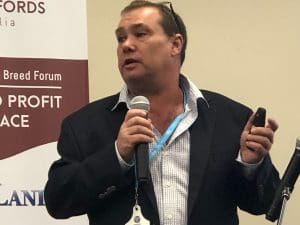
JBS’ Mark Inglis at the Herefords Australia forum.
MEAT processor JBS Australia paid back its lamb chain investment in DEXA carcase measurement and robotics technology at its Bordertown plant in three years, the Hereford Australia’s Breed Forum was told yesterday.
About 140 delegates from throughout Australia and overseas attended the Hereford Australia’s first two-day forum at Hamilton in south-west Victoria to hear domestic and international speakers from the trade, research and breeding sectors.
This included the latest information on the uptake of DEXA (Dual Energy X-Ray Absorptiometry) technology from JBS Australia and Meat & Livestock Australia speakers.
JBS Australia farm assurance and supply chain manager Mark Inglis agreed DEXA and robotics had helped the company with its lamb processing costs, but the company was looking past DEXA to other technologies for beef.
“In lamb it certainly has, there is no doubt.
“We’ve put DEXA units and robotics in at Bordertown (2015) and at Brooklyn; Brooklyn we spent $13 million and at Bordertown we spent $8 million.
“The payback on Bordertown was about three years, so there is a really good payback, Brooklyn is going to be a bit longer obviously.”
Mr Inglis said JBS was using DEXA to run a robot for rib-cutting on its beef chain at the company’s Dinmore plant in Queensland.
“To put DEXA into a plant, our opinion is, it needs to be linked with robotics; that is where the cost benefit is.
“If you put DEXA in purely for producer feedback, the payback is too long,” he said.
“So as a processor, linking it to robotics, and then the upside is, if we link it to robotics, we then can give you that extra information back around lean meat yield back to producers.
“We are certainly going heavily forward in that direction on lamb,” Mr Inglis said.
“Are we in beef? I can tell you as a company we are not even looking at DEXA.”
“We are looking at hyperspectral cameras and we are looking at objective carcase measurement to be able to help us for chiller assessments of lean meat yield,” he said.
“But DEXA to us is not going to give us eating quality outcomes — lean meat yield is a detriment to eating quality, you need to balance it.”
Mr Inglis said JBS could handle a little bit less yield through its beef boning rooms.
“Because it is the eating quality side of it that is actually paying for it.
“We can make more money out of eating quality, so differentiating our brands, than we can out of running DEXA units.”
Mr Inglis said linking robotics to DEXA decreased the investment cost payback time, but the technology did not remove many labour units from the chain.
“When we put it into Bordertown, it took about 7-8 people out of the boning room.
“They didn’t lose their jobs, what it allowed us to do was to go from one shift at that time to two shifts; it created an extra 200 jobs by putting the robots in, because it organises your room,” he said.
“And then they ended up having a housing shortage in Bordertown for all the extra staff.”
Mr Inglis said DEXA-linked robotics added value to cuts by enabling ‘millimetre-perfect’ robotic cutting through the carcase in the right spot.
“It makes sure you got every single bit of that loin and every single bit of that rack in the highest dollar value – that’s where the money is.
“By keeping human hands away from it, the shelf life it just went through the roof, which is what you want, especially when you are exporting product to the US.”
Mr Inglis said DEXA is not the only technology out there. He said he had met with people marketing CT scan equipment which is being used on horses.
He said the footprint of a DEXA unit in a plant is huge, and they contain about 10 tonnes of lead meaning floors have to be reinforced.
“Those CT scanners, those cone scanners, we could set up in a space about this big, with an arm that as a carcase came through it just scans the carcase like that.
“I think DEXA might be the catalyst for certainly the OCM stuff, and going forward, but there are going to other technologies come on board, and I think it will happen fairly quickly.”
MLA’s general manager, producer consultation and adoption manager, Michael Crowley, said DEXA “from a smallstock point of view is really going ahead.”
“If you look at which companies are looking to install DEXA in small stock it is to drive some level of automation.
“So when we look at it in beef, we are looking at it in a couple of ways.
“Again I think what will drive DEXA will be from plants looking to drive some level of automation in beef, and I think what we will also look at is how other yield outcomes will be compared back to a DEXA outcome.”
Mr Crowley said in the short-term the industry probably “won’t see a flood of DEXA installations.”
“What we will see is a handful.”
There is DEXA installation on trial at Teys’ Rockhampton plant and once the value of having the technology is proven others will take it on, Mr Crowley said.

HAVE YOUR SAY